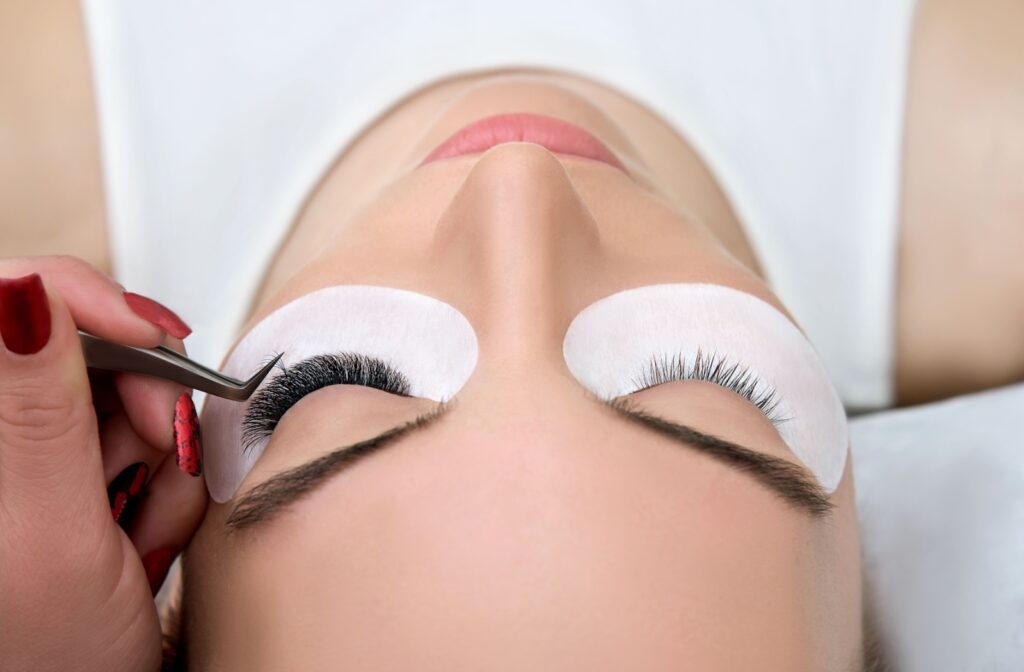Eyelash extensions are a popular beauty trend, offering fuller, longer lashes without daily mascara application.
But as stunning as they look, they can sometimes lead to an uncomfortable condition known as blepharitis. If you’ve noticed redness, irritation, or crusting around your eyelash line after getting extensions, despite proper care, it’s time to see your eye doctor.
Blepharitis is a common issue that can affect your eye health and vision or contribute to dry eye disease when left untreated.
It doesn’t mean you have to give up having fake eyelashes. However, blepharitis can be chronic, so you should follow your eye doctor’s advice on how often you should wear fake eyelashes.
What Is Blepharitis?
Blepharitis is an inflammation of the eyelids that affects the area where your eyelashes grow. It often presents with redness, swelling, irritation, and flaky skin around the lower or upper lash line.
While blepharitis isn’t typically a serious or sight-threatening condition, it can be quite uncomfortable. Blepharitis can also lead to complications if untreated, including styes, dry eye, or even lash loss.
The 2 main types of blepharitis are:
- Anterior blepharitis affects the outer edge of the eyelid, where the eyelashes attach
- Posterior blepharitis affects the inner eyelid & is caused by oil gland problems
Common Blepharitis Symptoms
Symptoms to watch for:
- Red, irritated, or swollen eyelids
- Crusting around the lash roots
- Waking up with dry eyes
- Sensitivity to light
- Frequent tearing or watery eyes
While blepharitis can develop naturally, eyelash extensions may heighten your risk.
How Eyelash Extensions Can Cause Blepharitis
Eyelash extensions don’t directly cause blepharitis, but applying, wearing, and maintaining them can create a breeding ground for irritation and bacteria.
Allergic Reactions
The adhesive glue used for lash extensions can contain irritants like formaldehyde, which may trigger allergic reactions in some people. The resulting inflammation can lead to blepharitis-like symptoms.
Bacterial Buildup
Extensions can make it harder to clean your lashes thoroughly, allowing bacteria, dead skin cells, and cosmetic residues to accumulate along your lash line.
Blocked Oil Glands
The eyelash extensions’ added weight and placement can interfere with your natural oil glands, leading to clogged ducts and posterior blepharitis.
Irritation from Friction
When your extensions are too long or applied poorly, your lashes can rub against your eyelids and cause irritation and inflammation over time.

Caring for Your Extensions & Your Eyes
Does this mean you need to quit extensions altogether? Not necessarily, but proper care of your lashes and eyelid hygiene is essential. Follow these tips to help minimize your risk of developing blepharitis while enjoying your extensions.
Choose the Right Type of Extension
Not all lash extensions are created equal. Look for hypoallergenic materials and formaldehyde-free adhesives to reduce your chances of a reaction. Lash technicians may recommend lighter extensions or shorter lengths to minimize eyelid irritation and strain.
Choose a Reputable Technician
Always go to a certified, experienced lash technician. They should follow strict hygiene practices, such as sterile tools and high-quality adhesives. A reputable lash technician will also assess your natural lashes and give you honest advice on what works for your eye shape and lash type.
Do a Patch Test
Before committing to lash extensions, ask your technician to perform a patch test with the adhesive. This simple step can help identify potential allergies or sensitivities before they escalate.
Proper Cleaning Techniques
Keeping your lash extensions clean is critical to preventing blepharitis. Here’s how to do it right:
- Use a gentle, oil-free cleanser or a lash-safe cleansing foam made for extensions
- Avoid rubbing your eyes or scrubbing at your lashes to prevent damage & irritation
- Clean your lashes every 3 days to remove debris & bacteria & help prevent buildup
Take Regular Breaks from Extensions
Consider giving your natural lashes a break every few months to minimize wear and tear on your lids and prevent long-term irritation. Using growth serums or nourishing mascaras during this downtime can help keep your natural lashes healthy and strong.
Adopting these habits can help protect your lashes and your overall eye health.
When Should You See Your Doctor?
When you’re experiencing persistent redness, swelling, or discomfort despite proper lash care and eyelid hygiene, it’s time to book an appointment with your eye doctor. Blepharitis that is left untreated can lead to long-term complications like:
- Chronic dry eye
- Frequent styes or chalazion
- Loss of eyelashes
- Corneal ulcers
Your eye doctor can identify the underlying cause of your symptoms and provide targeted treatments such as medicated eye drops, prescription ointments, or even in-office procedures like BlephEx.
Prompt, professional care is key to clearing the issue and preventing future flare-ups, so don’t hesitate to seek help.
Get Symptom Relief Today to Protect Your Lashes
Your eyes are precious, and taking proactive steps to protect them while wearing lash extensions is crucial. If blepharitis symptoms affect your comfort or eye health, contact our team at Advance Eye Care Center for tailored solutions.





